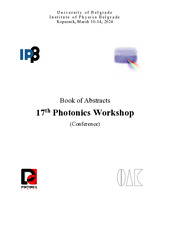Приказ основних података о документу
Hemocompatibility evaluation of N-doped carbon quantum dots
| dc.creator | Ristić, Biljana | |
| dc.creator | Trpkov, Đorđe | |
| dc.creator | Drvenica, Ivana | |
| dc.creator | Dojčilović, Radovan | |
| dc.creator | Đukić, Tamara | |
| dc.creator | Tošić, Dragana | |
| dc.creator | Pajović, Jelena | |
| dc.creator | Božanić, Dušan K. | |
| dc.creator | Trivanović, Drenka | |
| dc.creator | Matić, Tamara | |
| dc.creator | Sredojević, Dušan | |
| dc.creator | Ilić, Vesna | |
| dc.creator | Đoković, Vladimir | |
| dc.date.accessioned | 2024-04-02T20:43:20Z | |
| dc.date.available | 2024-04-02T20:43:20Z | |
| dc.date.issued | 2024 | |
| dc.identifier.uri | http://rimi.imi.bg.ac.rs/handle/123456789/1471 | |
| dc.description.abstract | Nitrogen-doped carbon quantum dots (N-CQDs) are promising next generation nanomaterials for potential biomedical applications such as bioimaging, biosensing, and drug/gene delivery. However, N-CQDs biocompatibility has not been extensively investigated. Here, we report physico-chemical characteristics of newly synthetized N-CQDs and their effects on red blood cells (RBC), by analyzing their hemolytic activity, impact on RBC rheology/morphology, and oxidative stress induction. N-CQDs were prepared by hydrothermal method using citric acid and urea as precursors. Structural analyses of as prepared N-GQDs, observed by HRTEM/EDS, showed that the lateral dimensions of the particles are in the 10 to 20 nm range, as well as that the carbon, oxygen, and nitrogen are present in the nanosystem. Based on AFM measurements, the average height of N-CQDs was 3.9±0.08 Å. Photoluminescence emission (PLE) spectrum demonstrated that N-CQDs exhibit stable and strong fluorescence in green (520 nm) region, upon 410 nm excitation. FTIR spectroscopy indicated vibrational bands, characteristic for carbon structures and primary amines (Ndoping). N-CQDs were negatively charged with an average Zeta potential of -15.3 mV as confirmed by DLS. To investigate hemocompatibility of N-CQDs, the RBC, the most abundant cells in blood, were treated with different concentration of N-CQDs (10-400 ug/ml) for 2h. Obtained results showed that there was no hemolytic activity. Moreover, ektacytometry analysis demonstrated that N-CQDs did not affect deformability of RBC. Fluorescent microscopy analyses revealed that treatment with N-CQDs did not induce significant morphological aberrant forms of RBC which was also confirmed by SEM analyses. Flow cytometry confirmed only slight RBC morphological changes based on FSC/SSC analysis. Furthermore, using ROS sensitive dye flow cytometry analyses suggested that N-CQDs did not induce oxidative stress in RBC. Taken together, our findings highlighted that exposure of RBC to N-CQDs only led to the attachment of N-CQDs on RBC membranes, but there is no other evidence of their nanotoxicity. These findings suggested that N-CQDs synthetized from ecofriendly precursors are potentially biocompatible and safe for biomedical application. | sr |
| dc.language.iso | en | sr |
| dc.publisher | Belgrade : Institute of Physics | sr |
| dc.rights | openAccess | sr |
| dc.rights.uri | https://creativecommons.org/licenses/by-nc-sa/4.0/ | |
| dc.source | Book of Abstracts: 17th Photonics Workshop, (Conference), Kopaonik, March 10-14, 2024 | sr |
| dc.title | Hemocompatibility evaluation of N-doped carbon quantum dots | sr |
| dc.type | conferenceObject | sr |
| dc.rights.license | BY-NC-SA | sr |
| dc.citation.epage | 47 | |
| dc.citation.spage | 47 | |
| dc.identifier.fulltext | http://rimi.imi.bg.ac.rs/bitstream/id/3477/Biljana_Ristic_Photonica_Workshop_pub_2024.pdf | |
| dc.identifier.rcub | https://hdl.handle.net/21.15107/rcub_rimi_1471 | |
| dc.type.version | publishedVersion | sr |

